The cost of frozen shoulder treatment in Iran
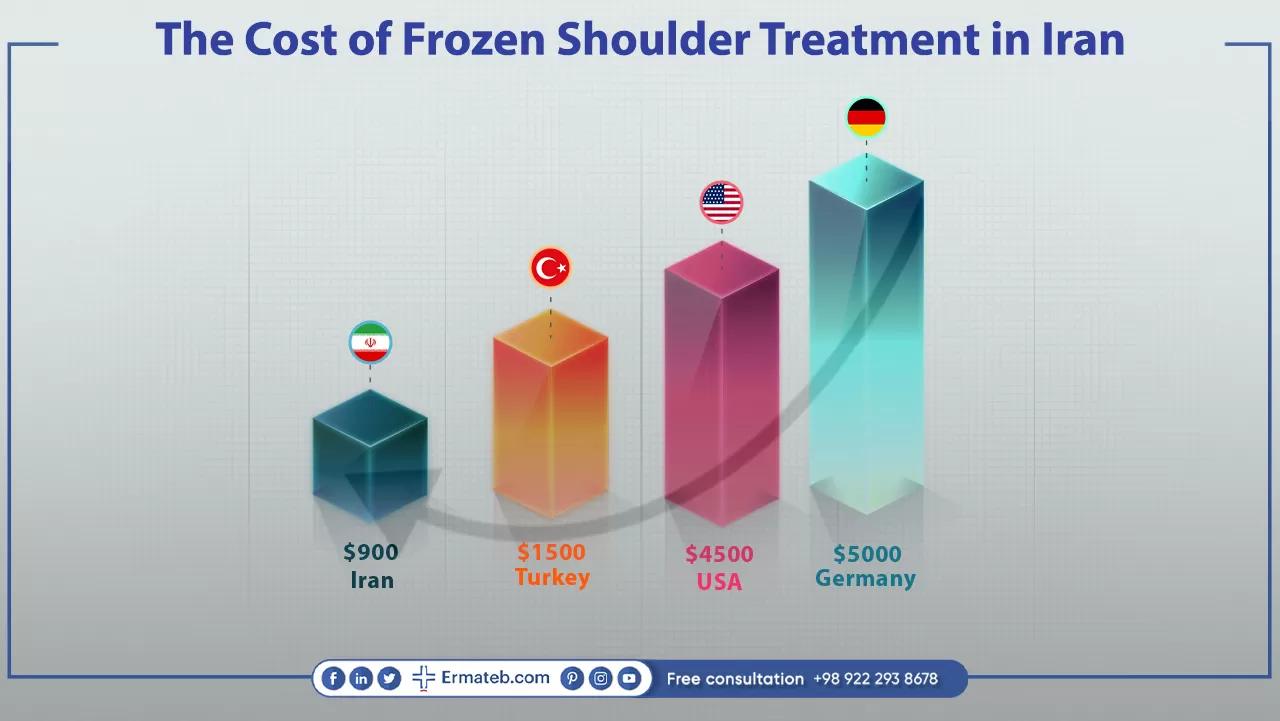
Like other surgeries in Iran such as carpal tunnel surgery in Iran, or shoulder replacement in Iran, the cost of a frozen shoulder treatment in Iran varies due to some factors such as the type of treatment. However, you can find the cost in Iran 900$ on average. We should note that the costs are much cheaper in Iran compared to other countries due to the low currency of Iran. For instance, you can find the cost of the same treatment in Turkey 1500$, 4,500 in the US, and about 5,000 in Germany.
Treatments for frozen shoulder
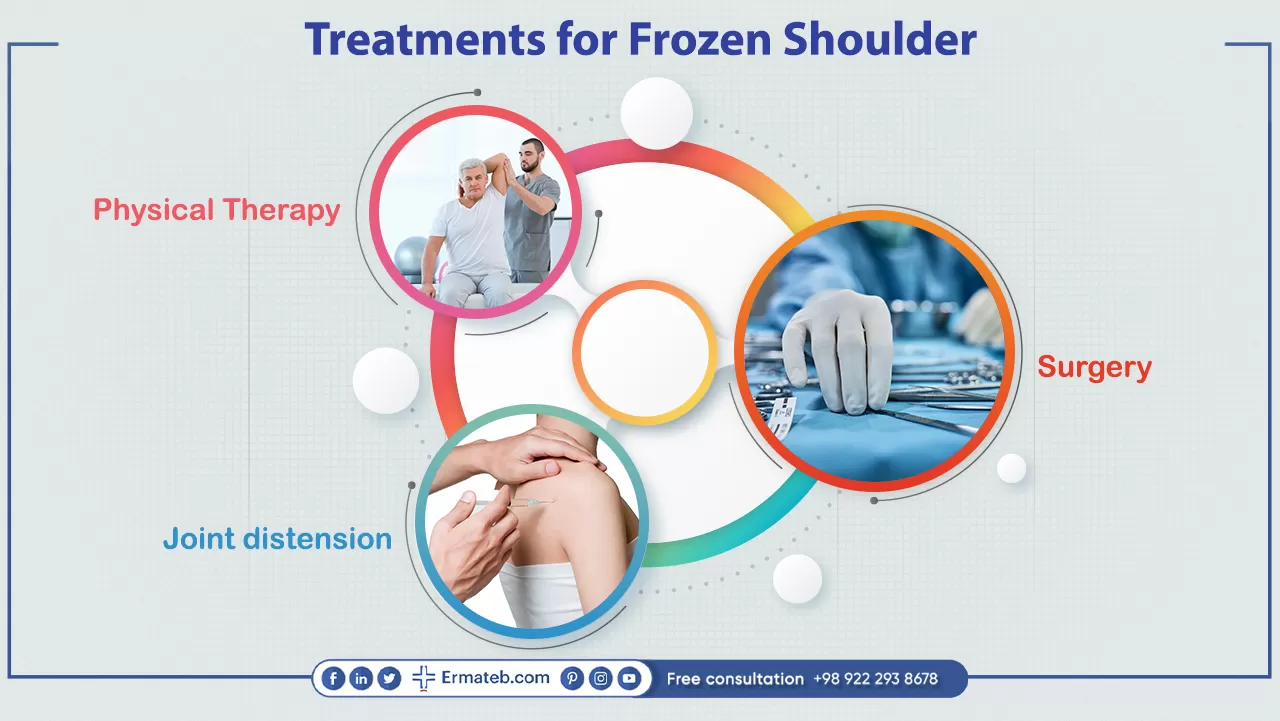
Frozen shoulder treatment includes range-of-motion exercises. It is not normal for a frozen shoulder to recur in the same shoulder. However, some individuals can develop it in the other shoulder, usually in five years. Usually, a frozen shoulder eventually gets better on its own, even if the person doesn’t treat it.
Over-the-counter nonsteroidal anti-inflammatory drugs (NSAIDs) such as ibuprofen or aspirin can help relieve the pain and inflammation in the shoulder. If these medications don’t help, the doctor might prescribe a stronger medication.
If the person’s symptoms are severe or don’t improve over time, the doctor might recommend other kinds of frozen shoulder treatment, such as:
1.Joint distension:
This means the doctor will inject sterile water into the person’s shoulder capsule to stretch it. It can help the person move their shoulder more easily.
2.Physical therapy:
This is often used for a frozen shoulder; however, it is not always effective. Physical therapy may be more useful during certain phases of a frozen shoulder than others.
3.Surgery:
In very rare cases, it is necessary to treat a frozen shoulder. If other treatments haven’t helped, the doctor may suggest arthroscopic surgery (which is a less-invasive type of surgery that uses cameras and small tools) to eliminate scar tissue.
Shoulder manipulation helps loosen up the shoulder tissue, however, it is rarely used since the arthroscopic procedure has better results. In this method, the doctor forcefully moves the person’s shoulder while you are under general anesthesia.
Symptoms of frozen shoulder
The symptoms of a frozen shoulder typically develop in three levels:
1.Freezing stage:
Any movement of your shoulder causes pain, and your shoulder's ability to move becomes limited. This stage, which is called the freezing stage, lasts from 2 to 9 months.
2.Frozen stage:
In this stage, pain might lessen. However, your shoulder becomes stiffer. Using your shoulder becomes more difficult, and usually, this stage lasts from 4 to 12 months.
3.Thawing stage:
In the third stage, your shoulder's ability to move begins to improve. This stage lasts from 5 to 24 months.
For some individuals, the pain may worsen at night, sometimes disrupting sleep.
Risk factors
Certain factors can increase the risk of developing a frozen shoulder. These factors include:
1.Age and sex:
People who are 40 and older, especially women, are more likely to have frozen shoulders.
2.Immobility:
Individuals who've had to keep their shoulder somewhat still are at higher risk of developing a frozen shoulder. Several factors can cause restricted movement, including rotator cuff injury, stroke, broken arm, and recovery from an operation.
3.Systemic diseases:
Certain diseases can increase the risk of a frozen shoulder. The diseases that might increase risk are diabetes, overactive thyroid (also called hyperthyroidism), underactive thyroid (also called hypothyroidism), cardiovascular disease, and Parkinson's disease.
Frozen shoulder Prevention
One of the most common factors that lead to a frozen shoulder is not moving a shoulder while recovering from a shoulder injury, broken arm, surgery, or stroke. If you've had an injury or surgery that makes it difficult for you to move your shoulder, talk to the healthcare provider about exercises that can help you maintain your ability to move the shoulder joint.
Frozen shoulder quick treatment
Unfortunately, there is no fast cure for a frozen shoulder. However, you might be able to ease some frozen shoulder symptoms and signs with some tips such as:
1.Hot/cold compression packs:
Applying a cold or heat to your shoulder can ease swelling and pain. Warm compresses increase blood flow to your inflamed area, while cold compresses slow blood flow and so decrease swelling and pain. You can alternate between these two. For heat compression, use a heating pad or you can warm a moist towel in the microwave. After that, apply it to your shoulder for about 20 minutes, three times a day. For cold compression, wrap an ice pack or you can use a bag of frozen vegetables in a towel. Then apply it to your shoulder every 2 to 4 hours for just 20 minutes at a time and no more. If you are alternating the two, apply heat for about 15 to 20 minutes, and then a few hours later, apply ice.
2.Transcutaneous electrical nerve stimulation (TENS):
Transcutaneous electrical nerve stimulation or TENS therapy uses a low-voltage electrical current to change or block how you perceive pain. However, it still needs more research into how it might work. Some doctors think it can activate nerve cells that block pain signals. The current may also boost the body’s natural painkillers, a group of hormones which are called endorphins.
Frozen Shoulder Exercises
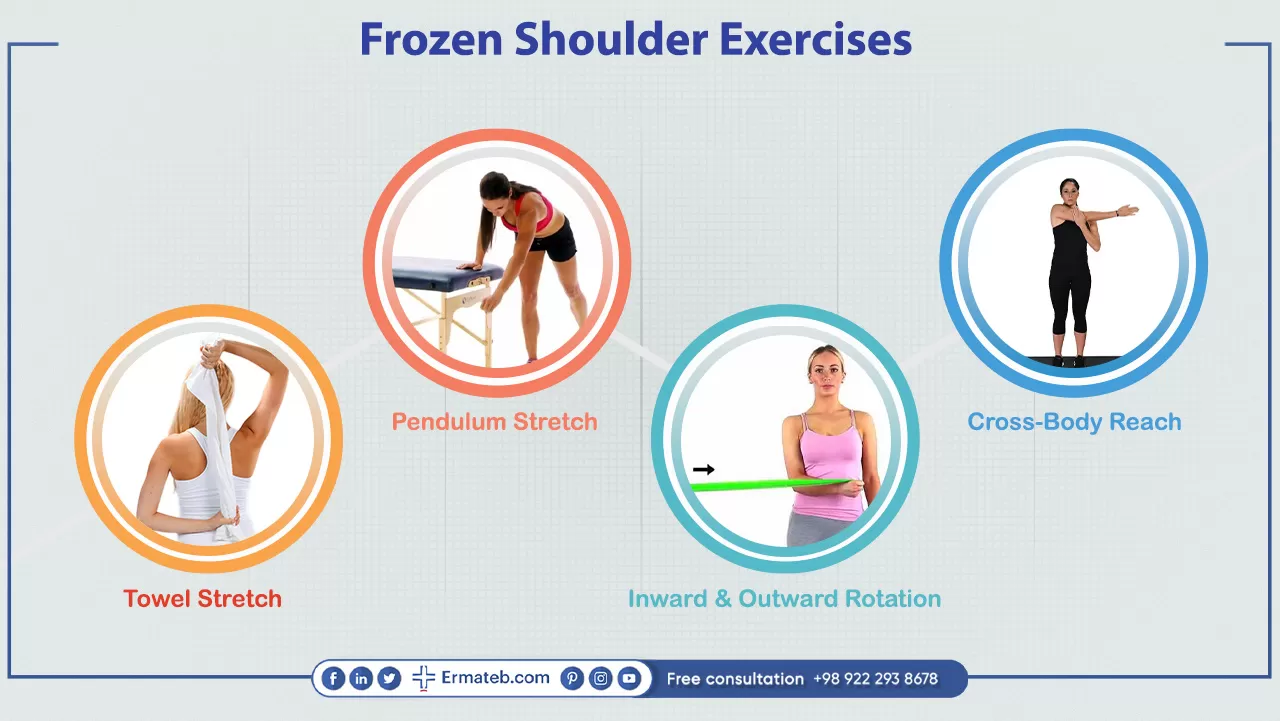
Increasing the mobility in the person’s shoulder with gentle stretching exercises can help to treat and even prevent a frozen shoulder. Check with the doctor before trying any exercises for your frozen shoulder. Go slowly, and modify or stop any very painful exercise.
You should warm up your shoulders before you get started. The best way to do that is to take a warm bath or a shower. Another option you can consider is to use a heating pad or a moist, microwaved towel.
For the following exercises, stretch until you feel tension, but not so much that you are in pain. The exercises can be:
1.Pendulum stretch:
First, stand with your arms at your side and your shoulders relaxed. Lean slightly forward and allow your affected arm to hang. Now, if needed, you can rest the hand of the good arm on a table for support. After that, swing your hanging arm in a circle about a foot in diameter 10 times in one direction and then 10 times in the other direction. As the pain decreases and your mobility increases, make the circles bigger. As the symptoms improve, you can do the exercises while holding a light weight of 3 to 5 pounds.
2.Cross-body reach:
Place the hand of the good arm on the elbow of your hurt arm. Lift the hurt arm up and across your chest until you feel the stretch in the shoulder. Now hold it for about 15 to 20 seconds. You should repeat 10 to 20 times a day.
3.Towel stretch:
First, stand and hold each end of a 3-foot-long towel behind your back vertically, with the affected arm holding the bottom edge of the towel and the good arm holding the top edge. Now, slowly raise the unaffected arm up your back until you feel the stretch in the shoulder. You should hold it for 10 seconds. Do it five times, twice a day for 5 days.
4.Outward rotation:
First, stand with the upper arms against your sides and your elbows bent at a 90-degree angle. Now hold each end of a rubber exercise band in each hand. Keep your good arm still and gently pull the affected arm out to your side for 2-3 inches. You should it hold for 5 seconds. Repeat about 10-15 times daily.
5.Inward rotation:
First, stand next to a closed door. Loop one end of an exercise band around the doorknob and then hold the other end in the hand of the affected arm. Now with your elbow at a 90-degree angle and your upper arm by your side, pull the band toward your body for 2-3 inches. You should hold for 5 seconds, and repeat 10-15 times a day.


 Arabic
Arabic
 German
German
 Persian (Farsi)
Persian (Farsi)
 Russian
Russian
 Beauty
Beauty


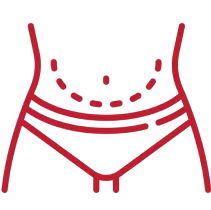
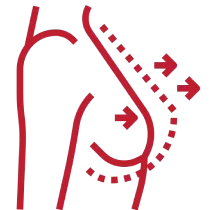

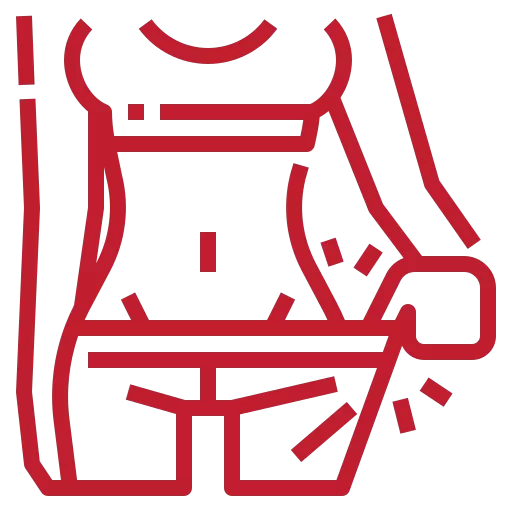
 Medical
Medical





 Hotels
Hotels
 Hospitals
Hospitals

